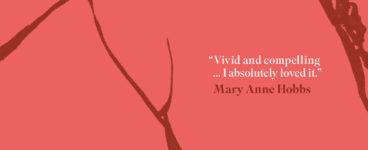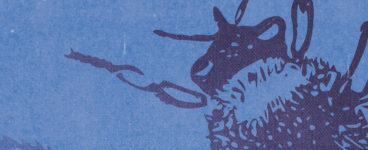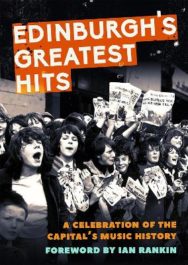‘I think one of Edinburgh’s strengths is its creativity and eclectic spirit.’
Edinburgh is a city with a lot of history and heritage resting on its streets, and in terms of music, it’s no different. The four authors of Edinburgh’s Greatest Hits bring together decades of music fandom, journalism and love of the form to collate a real celebration and documentation of the city’s musical exploits, from hosting Bowie to the famed Nirvana gig, and much more across the thriving scene. We talk to Jim Byers of Edinburgh Music Lovers and Jonathan Trew of Edinburgh Music Tours to learn more.
Edinburgh’s Greatest Hits: A Celebration of the Capital’s Music History
By Jim Byers, Jonathan Trew, Fiona Shepherd, and Alison Stroak
Published by Polygon
Could you tell us a little of what to expect from the book?
Jonathan Trew, Edinburgh Music Tours: It is a collection of quirky stories and memorable moments from Edinburgh’s music scene over the years. It covers bands that have stayed, played and made music in Edinburgh along with the venues that hosted them and, occasionally, the antics of the audiences that went along to see their idols. The stories are those which tickled us, made us smile or brought back fond memories. It is not a weighty tome or a comprehensive checklist of every band that ever played the city.
What drew you to the topic of Edinburgh’s hidden music heritage? And how did this collaboration come about?
Jim Byers, Edinburgh Music Lovers: I’ve had some of my greatest music experiences in Edinburgh but as a fan growing up here and when I was working as a music writer in Edinburgh, I always felt the city was overlooked a bit and maybe hid its light under a bushel a bit. That’s one of the reasons Edinburgh Music Lovers was created – to help talk about music in Edinburgh in a positive way and get it on more people’s radar.
In 2020, while having a coffee and scrolling through Twitter I came across XpoNorth’s Tweet Pitch which gives writers from across Scotland the chance to pitch their work to a panel of Scotland’s leading literary agents and publishers.
Fuelled by espresso, I quickly came up with the idea of pitching a book about Edinburgh’s music story and ran it past my one-time colleague and long-time pal Jonathan Trew who was many moons ago Music Editor at The List when I was a young music and clubs writer.
With his help and that of his colleague Fiona Shepherd, another List alumni and renowned music critic, we refined the idea and pitched it – Birlinn Books noticed the pitch and the rest is history!
JT: In 2015, Fiona shepherd, Alison Stroak and myself set up Glasgow Music City Tours to provide guided walking tours of Glasgow’s music scene. Fiona has worked as music journalist since the early Nineties; Alison had managed John Smiths bookshop in the Nineties when it was hangout for many Glasgow musicians and I had also worked as a music journalist through the Nineties and early 2000s. While Fiona and Alison are Glaswegians, I live in Edinburgh and starting Edinburgh Music Tours was a natural progression from the Glasgow tours. Put more succinctly, all three of us had been going to gigs and/or writing about music for a long time.
All of us had worked with Jim (Byers of Edinburgh Music Lovers) at various points in our careers and it was Jim that pitched the idea for the book at the Xpo North Tweet Pitch. Birlinn picked up on it and, apart from a slight Covid-related delay, here we are.
What is it about Edinburgh that has given it such a significant musical heritage, across gigs, venues, record stores, and the scene in general?
JT: You could argue that its status as the capital of Scotland played a role in attracting musicians. You could point to its strong folk scene and the bars and folk clubs that hosted the trad musicians. Having a college of art here has helped and the city’s large student population has also played a part in producing talent and providing audiences. Promoters such as Regular Music have been pivotal in putting on excellent gigs from touring bands and local artists. Venues have also been key. Every era had its own significant music venues. For me, in my Nineties heyday, The Venue on Calton Road was a sweetspot. The crossover between clubs and the music scene would also be a factor.
JB: I think one of Edinburgh’s strengths is its creativity and eclectic spirit. Some cities such as Manchester for example are linked at times with a scene or style, but arguably Edinburgh can’t be defined by a sound. There’s a thread of creativity running through the city and its music story, whether that’s through its pioneering promoters who made the city such a respected hub of live music in the 70s and 80s or the club promoters of today who have similarly put the city on the world map. You can also see that eclectic creative spirit in the acts that have emerged from the city – from the Young Fathers who are one of the most creative bands on the planet to the likes of Hamish Hawk and Callum Easter both of whom are utterly unique and gathering critical acclaim.
What were some stand out stories you came across in the process of the book? What would you consider some of the defining, or perhaps lesser-known musical moments?
JT: I like the tales of the unexpected: Bowie living in a flat on Drummond Street; Nirvana playing The Southern Bar; the Edinburgh audience heckling Dylan’s decision to go electric by playing their harmonicas. And let’s not forget the Bay City Rollers. Like many bands a few decades after their peak, they may seem outdated or even daft now but, at one point, they were one of the biggest bands in the world.
JB: For me, it was the perspective of pioneering promoter Pete Irvine who really helped define Edinburgh’s importance and in some ways helped validate the concept of the book in terms of shining a light on Edinburgh. With his stories of the events he put on in Edinburgh particularly in the 70s and 80s, such as Monday night gigs at Tiffanys, he demonstrated how Edinburgh pioneered the live music scene in Scotland and was a must-visit for all the best bands of the time, which is not something many people appreciate.
Music, naturally, plays a significant role in the book, and in many people’s lives. What’s your own relationship and history with music? Are there any stand out moments for you as a music fan? Bonus points if they are in Edinburgh!
JB: Music has been and continues to be a huge part of my life. As a young teenager, one of my first ever gigs was U2 at Murrayfield Stadium and it blew me away. Later I fell in love with house and techno music and became a regular at clubs like Yip Yap, Pure. And Taste As a dance music journalist, I went on to be lucky enough to go clubbing around the world and there’s no doubt that clubs like Yip Yap, Pure and Taste were right up there amongst the best. As a writer for magazines I made it my mission to help tell more people around the world about Edinburgh and that’s something I continue to be passionate about 20 years later.
JT: As a spotty teenager in the Eighties, I identified as a rocker or heavy metal fan. Unfortunately, in terms of looks, it was more hair metal: pixie boots, striped jeans, waistcoat and a mullet. By my late teens and early twenties I was tired of looking like a Muppet and had gravitated more towards the goth end of the musical spectrum. Darklands by the Jesus and Mary Chain was and is one of my favourite records.
Working as a music journalist broadened my tastes. Especially during the mid-Nineties when Britpop exploded. I spent two years trying and failing to get an interview with Jarvis Cocker of Pulp although I still enjoyed seeing them play at the Corn Exchange. I missed Oasis playing the Belle Angele. The venue promoter had phoned to get me to come down but I nixed it as I had been out a few nights in a row before. It’s not quite up there with failing to sign The Beatles but, for a music journalist, it was a stupid mistake.
Nick Cave playing the Ross Bandstand in Princes Street Gardens remains a stand-out gig and I should also mention the Polly Harvey concert at Glasgow’s Barrowlands when she was touring the To Bring You My Love album. Springsteen doing an acoustic gig at The Playhouse for the Ghost of Tom Joad album was pretty special as well.
Another one that sticks in the memory was Moby at the Liquid Rooms just before his Play album went global. Back then, he was a slightly odd, little-known techno DJ. If memory serves, the support act was some sort of leather-bound female rock band that spent more time pretending to whip each other than playing their instruments. Seemed a strange choice of support for Moby who was better known for being a straight-edged vegan at the time.
There are a lot of gigs featured that are a ‘Wish you’d been there’ compilation (The Beatles on Lothian Road, Nirvana in the Southern Bar…) – what are your gigs from Edinburgh’s vast history that you personally wish you’d been at and why?
JT: Where to start? The Beatles and the Rollers were before my time but I would love to have seen them perform. As much for the crowd hysteria as anything else. The Clash at the Playhouse would have been a belter and is reckoned to be the gig which inspired most of Scotland’s punk and post-punk bands. Led Zep at the Usher Hall would also make the wishlist. Seeing them in their pomp would have made both the teenage me and the current version very happy.
JB: Nirvana at The Southern Bar would have been amazing.
The music industry at large has faced significant change over the last many years with venue closures far and wide, and Edinburgh wasn’t spared from this. How do you think Edinburgh’s scene has changed and evolved within this? What were some of the biggest shifts it’s faced?
JB: Venues come and go over time. For me, one of things that has perhaps held Edinburgh back a bit is the focus on venues that have closed – it created a negative narrative that lingered and together with other issues such as noise complaints, haven’t helped. With this book and with EML, I want to help build a much more positive narrative around music in Edinburgh in a way that hopefully helps bring more music fans to the city to go to gigs and to listen to Edinburgh acts.
There’s no escaping that Covid has been awful for music, but there are many things to be positive and excited about. New venues are emerging such as the Dunard Centre, old venues like Leith Theatre are being revived, existing venues such as Sneaky Petes, Summerhall and Usher Hall continue to programme superb gigs, new artists such as Hamish Hawk and Swim School are making waves and lots of other great music things are happening such as EHFM the community radio station.
JT: As with everywhere else, streaming, venue closures and Covid have had a baleful effect. But it’s not all bad news. Edinburgh will soon have the Dunard Centre, its first new concert hall for a century. There are ongoing talks proposing a new venue in Princes Street Gardens and organisations such as the Hidden Door art festival have shown how new life can be breathed into unexpected spaces such as the Granton Gasworks. Leith Theatre is reviving, partly thanks to Edinburgh International Festival continuing to use the space for its popular music strand. The Royal Highland Centre has long been used for dance music events. This summer, DF Concerts are running a series of gigs – Madness, Fatboy Slim, Snow Patrol, Biffy Clyro, James & 50 Cent – at the venue. We should also mention Regular Music’s series of concerts on Edinburgh Castle Esplanade in July. Things are bouncing back.
How do you see the music scene moving forward as we all start returning to ‘normal’ after these past few years?
JT: Events of the last couple of years and even the last couple of months show how easy the best laid plans can gang horribly agley so all predictions should be taken with a large pinch of salt. However, it would not be a massive surprise if more spaces were repurposed for entertainment venues. As shopping moves online more and more city centre retail premises will be lying empty. They might make good music venues. They tend not to have neighbours who will complain about noise.
On a more general note, people will always make music and people will always want to hear music, go to gigs and experience the visceral thrill of a live band. That won’t change no matter how many venues come and go or how technology evolves. Not everyone will want to attend a gig in the Metaverse.
What do you hope readers take from your book?
JT: I hope it makes them smile. I hope it jogs a few memories and I hope it encourages them to go out and see band. Or book onto Edinburgh Music Tours.
JB: I hope the book helps put Edinburgh’s music story on more people’s radar and that it encourages more people to think about visiting Edinburgh to go to gigs and listen to acts from Edinburgh.
Bonus question: Favourite song at the moment.
JT: It’s a Long Way to the Top (If You Wanna Rock ‘n’ Roll) by ACDC is always my favourite song but Arcade Fire’s new track – The Lightning – is a happy reminder of their gig at Edinburgh Castle.
JB: Keeping with the Edinburgh theme, Make Big Money Fast Online Now by another exciting emerging act, Redolent.
Learn more: EdinburghMusicLovers.com | @weareEML | Edinburgh Music City Tours
Edinburgh’s Greatest Hits by Jim Byers, Jonathan Trew, Fiona Shepherd, and Alison Stroak by Polygon, priced £9.99.
ALSO IN THIS ISSUE

 Q&A: One Body: A Retrospective by Catherine Simpson
Q&A: One Body: A Retrospective by Catherine Simpson
‘In speaking candidly about our bodies, we feel less alone and isolated. It enables us to ask for he …

 Life’s Stink & Honey
Life’s Stink & Honey
‘Thi sma snaw o the lambs is later than iver this year, / thi Mey’s near oot, daffies are droonin in …













